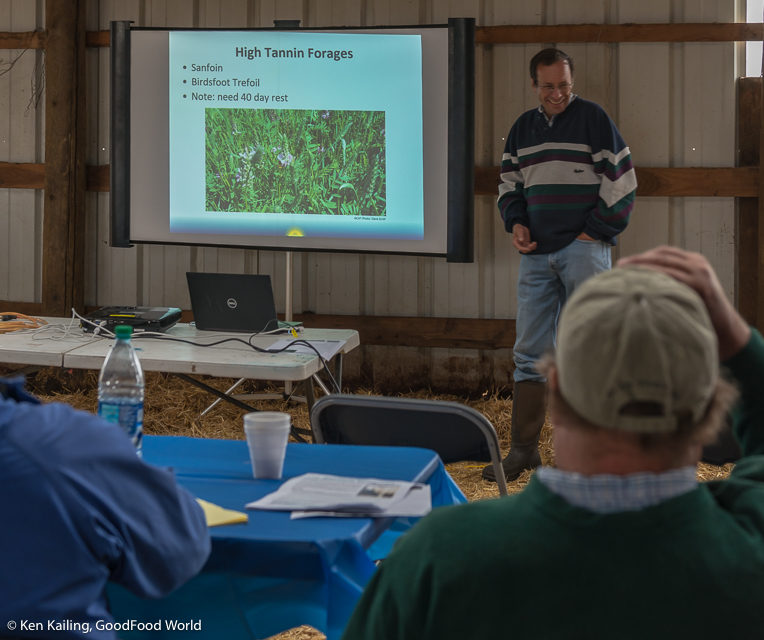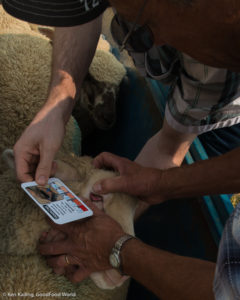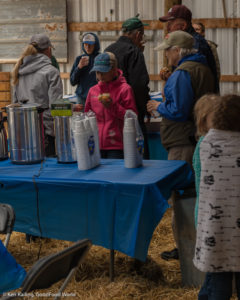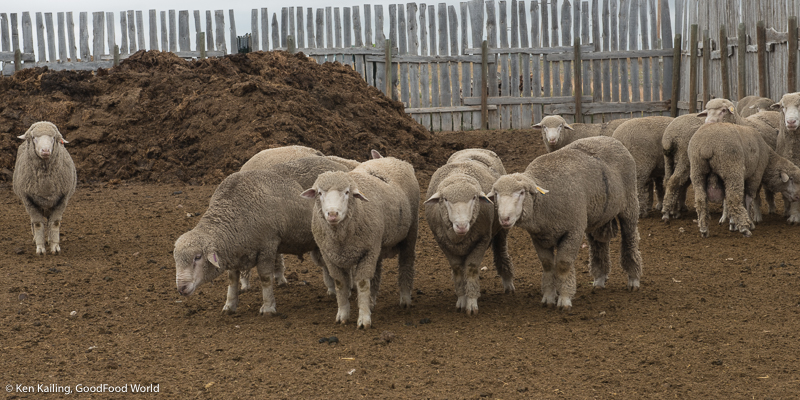(Take a virtual tour of the event here. Click on any image to launch the slide show.)
On a drizzly Saturday, August 10, 2019, Dave Scott (a livestock specialist with the National Center for Appropriate Technology, NCAT) and Brent Roeder (Montana State University, MSU, sheep specialist), lead a workshop on grazing, practices, integrated parasite management, FAMACHA© scoring, and new sheep identification and handling methods.

As Montanans are wont do, most of us thought nothing of driving 80+ miles for a field day on a rainy morning. The extra moisture certainly didn’t dampen our enthusiasm! As we arrived, pens full of lambs and sheep turned their heads to gravely watch us pull into the barnyard to park. A flock (herd?) of kids dodging between the cars and trucks ran past us trailing one small cowboy in a very big black hat, running flat out, and determined to catch up to the rest of the “big kids.”
Mid-August in north central Montana is NOT known for rain, and this event could easily have been called, “All Things Sheep, Kids (the 2-legged kind), Barber Pole Worms, and Mud… and Community.”
Our hosts set tables for 40+ attendees in a barn strewn with fresh straw. There was a table laden with coffee urns to keep us caffeinated, and bacon and salted caramel donuts to… well… definitely entice us all to add plenty of sugar, salt, and fat to the caffeine. (Confession: my first bacon and salted caramel donut was amazing – unfortunately, it will also be my last!)
All Things Parasite
While today’s field day purported to focus on “all things sheep,” in reality it was focused on Barber Pole Worms, a red and white, blood-sucking parasite that causes anemia, which leads to poor weight gain, reproductive and lambing problems, weakness, and even death.
Parasites are a challenging health problem affecting small ruminants like sheep and goats. Two factors can compound the problem: poor immunity and irrigated pastures.
Dave outlined the solution in a simple phrase: Integrated pest management. By taking a holistic approach – good animal husbandry, good stockmanship, and good pasture management – it IS possible to manage Haemonchus contortus (Barber Pole Worm), the most common parasite seen in sheep in Montana. While the solution is simple, it’s not necessarily easy.
First consider the lifecycle of the worms: Barber Pole lifecycle is 22 to 28 days, depending on temperature and moisture. Adult worms can live in the sheep abomasum (the fourth and final stomach compartment) for 6-8 months, shedding several thousand eggs per day. Those eggs are dropped by the sheep in their feces and develop into larvae that live on damp grass and other plants; thus irrigated pastures are the perfect environment for this parasite.
FAMACHA Scoring
 FAMACHA© is a simple method to identify which sheep in a flock require parasite treatment. Dave has taught the FAMACHA© method to Montana ranchers for a number of years and applies it to his own flock.
FAMACHA© is a simple method to identify which sheep in a flock require parasite treatment. Dave has taught the FAMACHA© method to Montana ranchers for a number of years and applies it to his own flock.
By comparing the degree of anemia displayed in the mucous membranes of the sheeps’ eyes – as indicated by the color of the membranes – it is possible to select only those that require treatment, rather than treating the entire flock prophylactically.
A pen containing a dozen or so lambs patiently – or not so patiently – waited their turn for novice ranchers to try their hands at positioning the animal’s head and rolling down the lower eyelid to reveal membranes ranging from pale pink to healthy rosy red. The sheep are “scored” with a number from 1-5; with 1 (the darkest color) indicating the lowest level of anemia and 5 (the lightest color) indicating the highest degree of anemia.
Those scoring 4 or 5 should be treated for parasites immediately; those scoring 1 or 2 do not need to be treated. Those scoring 3 should be treated under specific circumstances (see Why and How To Do FAMACHA© Scoring – link provided below). As Dave says, “Always err on the side of caution, treat if you have any concerns.”
Strategic Grazing
(A reminder – this timing advice applies to irrigated pastures.)
To limit the ingestion of larvae:
- Graze sheep for 4 days or fewer in each paddock, depending on the height and quality of grass and forbs.
- Move animals when plants are grazed down to 6-8 inches. It’s a good idea to err on the high side.
- Rest the pasture for 35 to 40 days before returning sheep to graze.
- Plant legumes such as Sanfoin and Birds Foot Trefoil, which contain condensed tannins. Those tannins can reduce the parasite load and improve digestion.
- Rotate cattle and/or horses on the paddocks between grazing sheep or goats.
- Wean lambs by placing ewes and lambs into two adjoining paddocks, separated by a sturdy fence. “Fenceline weaning” is less stressful on both lambs and ewes, as evidenced by much less calling back and forth between pairs. Less stress on the lambs decreases their susceptibility to worm infection.
Genetic Selection
- Some breeds are more resilient and less susceptible to worm infection; consider adding their genetics to your flock. Individuals in a flock may also be less susceptible, so tracking and breeding for resilience is important.
- Inheritance of reduced susceptibility is relatively high. And Dave notes that sires greatly determine the genetics of a flock. Tracking and documenting individual genetics is critical when breeding to improve parasitic resiliency.
Organic Remedies
Organic natural remedies include drenches (liquids administered orally by syringe) made from a mixture of natural products such as garlic, molasses, vegetable oil, and cider vinegar, and/or seaweed products and tree products.
Diatomaceous earth is often promoted as a natural de-wormer and it is sometimes said that the sharp edges of the diatoms kill worms and insects by damaging their outer protective cuticle or coating.
Handle with care – some studies have shown that continual ingestion of Diatomaceous earth can damage the ruminant’s intestinal lining, causing malabsorption, and impairing gut defenses through increased permeability.
In short, reduce stress; provide good, balanced nutrition, good quality pastures, supplementary feeding if required, and mineral licks where deficiencies have been identified; and manage grazing and genetic resilience in order to be most successful with organic remedies.
EID Technology
Sheep were among the first animals domesticated by humankind about 10,000 years ago, and much of what Dave and Brent discussed during the day is very similar to the way sheep were raised millennia ago.
Brent brought us back to the 21 Century in a hurry as he demonstrated Electronic ID (EID) Technology that is now available to track and document each lamb from birth to sale or harvest. By using RFID (Radio Frequency Identification) tags inserted in the lamb’s ear right after birth, each animal can be electronically identified using scanners, and a wide range of data collected that can be used to measure weight gain, document animal health and treatments, and track genetics. Record-keeping just got a whole lot easier!
With the most sophisticated of these tools including “smart scales,” it is possible to use weight, age, and other selected variables to automatically sort animals for culling/sale or breeding. For large flocks, sorting animals this way can save a huge amount of labor and drastically reduce errors.
There is a caveat here: the RFID tag has to stay in the animal’s ear! If it’s lost, the process to identify the “unknown” animal is literally like looking for a needle in a haystack!
It’s Holistic!
As Dave has said before:
Good animal husbandry depends on a holistic approach; incorporating and balancing all the elements of healthy animals, healthy soil, and healthy forage. How to get there?
Develop resistant and resilient livestock, reduce exposure to parasites while acknowledging that strong, healthy sheep can thrive with a moderate parasite load, practice good pasture management, and treat only those animals most affected by worms.
Better for the animals, better for the soil, and better for the rancher!
GoodFood World
Why do you see GoodFood World at farm days, food shows, food manufacturing plant tours, grain mills, grocery stores, and restaurants? We are looking for the strengths in our food system to highlight and promote the “good guys” and system weaknesses to shine the light of transparency on the “bad actors.”
Here’s how you can do your part:
- Let us know what’s going on in your area by emailing us links, announcements, and recommendations. If we can, we’ll be there.
- Go to our website – explore and discover nearly 10 years worth – thousands! – of articles, book reviews, profiles, and more.
- Sign up for our newsletter.
- Follow us on Facebook.
- Contact us to discuss our custom business and planning services.
- Make a donation to help defray some of our costs and become a part of the Good Food World!
Additional Reading
Why and How to Do FAMACHA© Scoring, University of Rhode Island, updated 2016.
The Benefits of Tannin-Containing Forages, Utah State University, 2013.
Tannins for Suppression of Internal Parasites, Journal of Animal Science, February 2003.
Managing Internal Parasites in Small Ruminants: Pasture Management, National Sustainable Agriculture Information Service, 2012.
Using Tannins to Control Parasites in Smallstock, Farmer’s Weekly, July 1, 2016.
Birdsfoot Trefoil, a Valuable Tannin-Containing Legume for Mixed Pastures, Plant Management Network, 2006.
Managing Internal Parasites in Organic Livestock Production Systems, NSW Department of Primary Industries, September 2017.
Managing Internal Parasites in Sheep and Goats, National Sustainable Agriculture Information Service, updated 2016.


